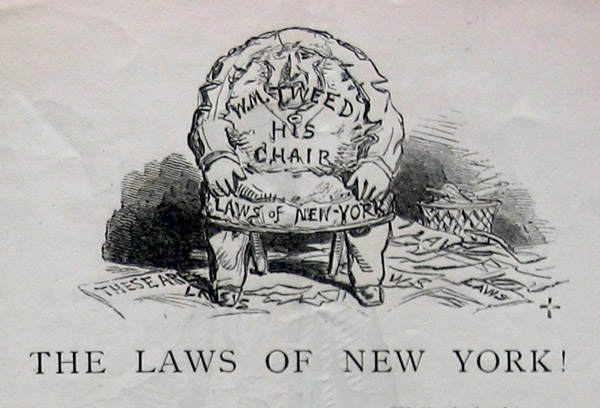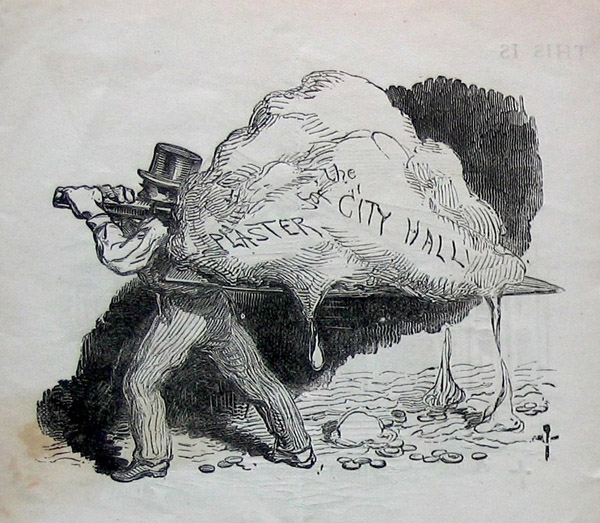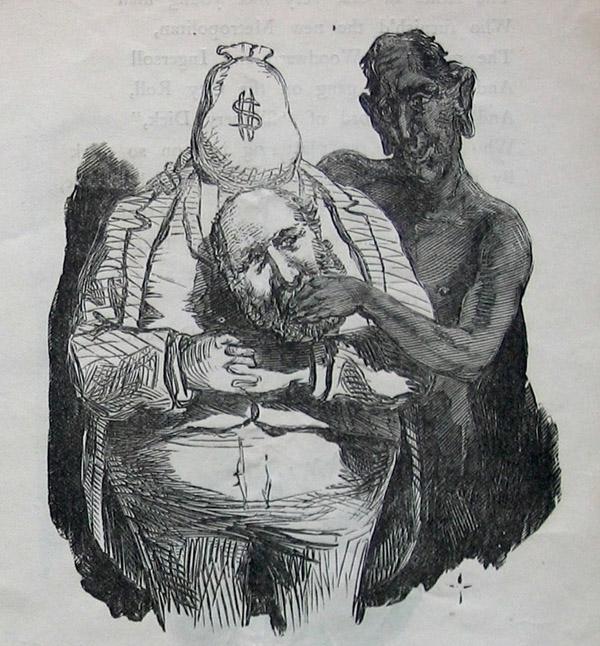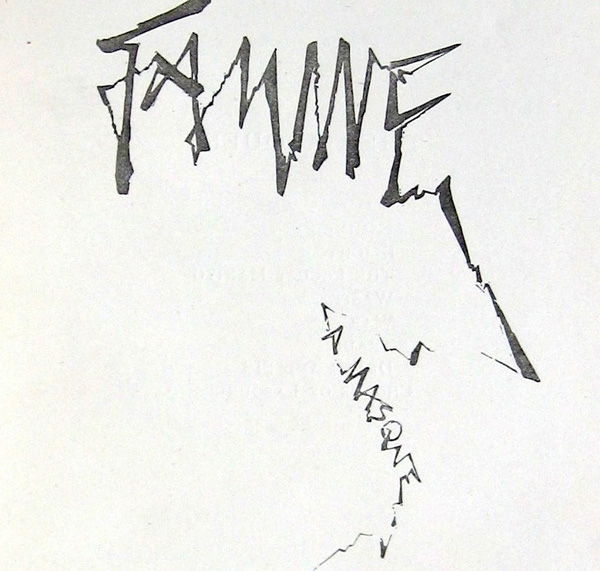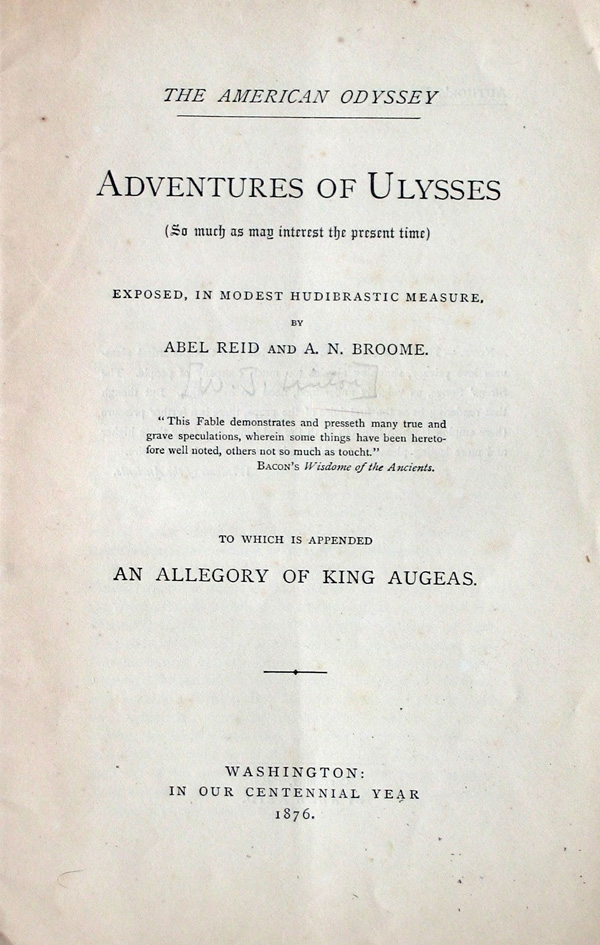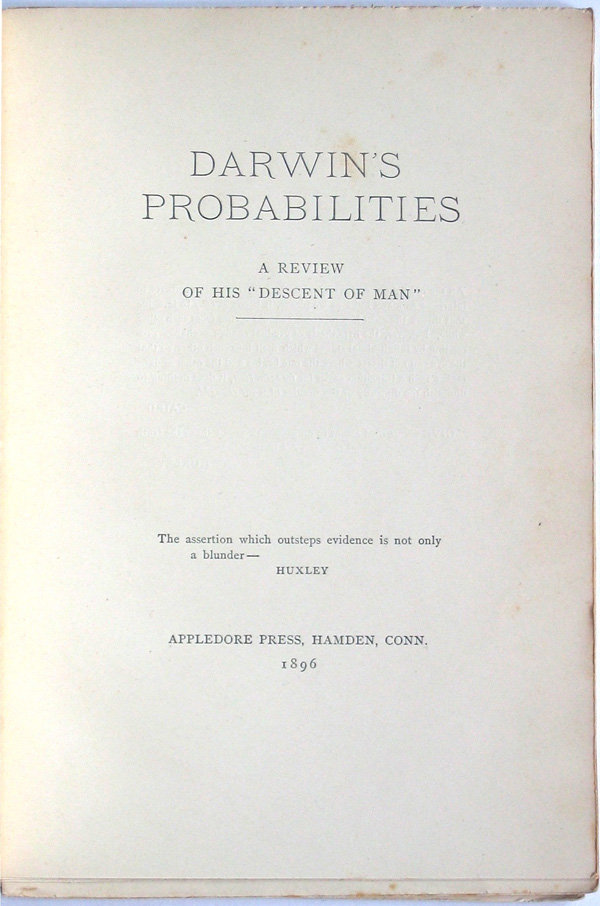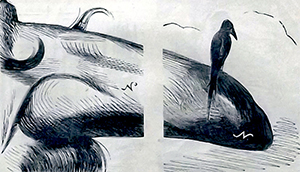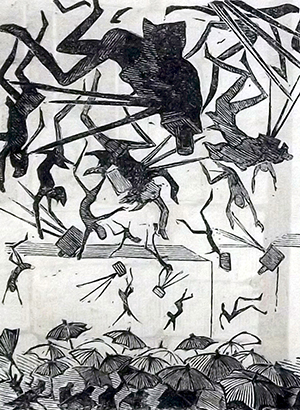Alexander Roob]
[May 14, 2012
Corrupted States of Plutocracy. W.J. Linton´s North America – Cycle.
Nicht übersetzt:
Lintoniana IX
God send the Indian luck! / Success to the buck! / May his scalps be many and quick! / Guard his war, O Lord! through the thick / Of his foes! Give him luck! (W.J. Linton, 1871)
In 1866 William James Linton moved to New York because, as he confessed in his autobiography, he “had little occupation in England, and thought the opportunity good to see the new country, with no fixed intention of remaining.” He was received with open arms by the members of his Unitarian and republican networks. In the beginning he managed to make a living as a teacher of the Wood Engraving Class at the Cooper Institute and only a short time later he became director of the engraving department of Leslie’s Weekly, one of the most popular illustrated papers. In the spring of 1870 he left New York and moved to a farmhouse called The Curtis Place, which he renamed Appledore, in the village of Hamden outside New Haven / Connecticut. Here he established his second private press with the proceeds from the Brantwood sale, more than twenty years before William Morris started to promote the wave of auteur presses.
In 1871 he saw a chance to realise his vision of a radical democratic republic in the Wild West. He became an agent of Edmund Davis, a friendly mining financier with socialist interests, and endeavoured to procure a purchaser for a hundred thousand acres of land in Kentucky. The plan failed, and in the same year he began publishing an impressive body of critical writings which revealed antidemocratic aspects of North American foreign and domestic politics.
Already in his first American publication, a brochure edition of his Rhymes and Reasons against Landlordism, which appeared 1867 in New York, he had left no doubt about the radical foundation of his views. Also the penname he used for most of his American pamphlets served as an indicator for his basic idea of a nationalization of land. The name Abel Reid stood for the right of the landless, embodied in the second son of Adam, who was slain by his brother, the initial landowner Cain.
The first of his America – critical writings The House that Tweed built (Cambridge / Mass. Nov. 1871) was targeted at New York’s infamous major William “Boss” Tweed and his unscrupulous Tammany Ring. This bizarre case of political corruption stood representative for the whole plutocratic system, which was established in the post-Civil War era, the so-called Gilded Age.
W.J. Linton, The House that Tweed built, Cambridge / Mass. Nov. 1871
Thomas Nast: The “Brains” (Boss Tweed), October 21, 1871, (MePri-Coll.)
During the tumultuous events of the Paris Commune and the hysterical debates around, Linton remained “one of the handful of people in the United States courageous enough to speak out and informed enough to understand.” (F.B. Smith) Although he recognized a decisive weakness in the activities of the Commune, which he saw caused by the Communard’s anarchic individualism and isolation, he did welcome it as a dawning of radical democratism. In his remarkable essay The Paris Commune. In Answer to the Calumnies of the “New York Tribune.” (Boston 1871) he accuses the venerable New York Tribune, which would preen itself of its accurate coverage, of having loaded their columns “with infamous rumours and malignant insinuations.” Linton provides detailed evidence of a tactics of slander by the popular press. He pamphlet thus provides a profound analysis of a crucial case of constructed history, a topic with which dealt with six years later in his conversation piece Voices of the Dead.
Famine (New Haven, 1875) is a Shelleyan masque, which analyzes the correlations between labour, trade and famine, and between waste and usury. It was written in the midst of the Long Depression with its high rates of unemployment. The fact that the prices of grain fell by nearly seventy percent imposed great hardships on farmers and planters in Europe and North America. For his illustration, Linton fell back again on a design by William Blake. The ornamental drawing he used as an exposition was taken from a kerography, which he had made for Gilchrist’s Life of Blake (Vol. I, p. 127). It shows two angels from Blake’s prophecy Europe pouring out the blight from their horns, which adulates the harvest. Linton had “added the word FAMINE to the block in his distinctive, spiky, slightly curved lettering, giving the design an immediate resemblance to a fully developed art nouveau page of the 1890s. It precedes by almost a decade Arthur Mackmurdo’s famous title-page for his book of Wren´s city churches, normally accepted as the earliest art nouveau page composition and a landmark in the evolution of the style.“ (F.B. Smith)
W.J. Linton, Famine , New Haven, 1875 (cover design) (MePri-Coll.)
W.J. Linton, Famine , New Haven, 1875 (engraving after William Blake) (MePri-Coll.)
Under his favourite penname Abel Reid Linton published a cycle of poems, which belongs to his strongest literary moments. Broadway Ballads shows him from a rare side of social reporting. The book was written on the occasion of the anniversary celebration of American independence in 1876 and is composed of a series of caustic sketches dealing with the human misery of mass unemployment and the disintegration of solidarity in the plutocratic metropolis of New York: portraits of homeless children, young prostitutes, immigrants driven into suicide, scenes of mass unemployment, and a series of short cuts from the central slum quarter Five Points. Poetic case studies such as Frozen to Death, Jan.10, 1875 about “Two men lying, stiff and stark / Frozen to death in Central Park,” which were related to newspaper announcements and police reports, anticipate the bleakness of a literary realism that started in the nineties with authors such as Stephen Crane and was continued by the investigative journalism of Jack London and Upton Sinclair. The social realism of the coeval Charles Dickens has to be conceived as a forerunner, especially his American travelogue from 1842. But whereas Dickens’s prose always remained stuck in Victorian sentimentality, entertaining and noncommittal, Linton’s lyrics had an analyzing, often undigestible, but always challenging Brechtian impulse.
The idea to create such a hellish vision of urban reality was considerably influenced by the example of James BV Thomson, whose bleak poem City of Dreadful Night had caused a literary stir two years before. In 1866 Thomson had published an inspired essay on William Blake in the National Reformer, the atheistic organ of his mentor Charles Bradlaugh. The double-page 110 -111 in Broadway Ballads can be considered in a strict sense as a response to the usage of Blake in the context of secularism or, in a wider sense, as a Lamennaisian objection against the threads of a narrowed Utilitarianism. This spread shows a graphic depiction of a Descent into Hell on the left side, which was taken from Blake’s America, and an engraving by Linton with the inscription God is not dead on the right. It is less challenging but rather entertaining to view this pictorial confrontation in the context of Thomson’s hymn to atheism, Address on the Opening of the New Hall of the Leicester Secular Society, that was published anonymously a few years later – illustrated with Linton’s translations of William Blake’s Job, – and to consider all probable and improbable correlations.
W.J. Linton (aka Abel Reid), Broadway Ballads, New York 1876 (engraving after William Blake) (MePri-Coll.)
The civil rights politics of President Ulysses Grant, which were in favour of Afro-Americans and Native Indians, should have suited Linton’s taste. But the two terms of his presidency were overshadowed by a series of corruption scandals, which had revealed the political constitution of the post-Civila War era as an unscrupulous oligarchic system. The old Chartist was also increasingly disappointed by Grant’s imperialistic foreign policies. In the centennial year 1876 he published The American Odyssey. Adventures of Ulysses, a Hudibrastic satire on Grant’s presidency. Though dry, cryptic and completely unfunny, The American Odyssey is full of numerous allusions to various affairs, in which Linton was mentally or physically involved. Grant’s first name, Ulysses, had enticed him to use Homer’s epos as a formula.
The first chapter refers to the Cyclops episode and, according to the wording of the preface, is meant to symbolize “the partial blindness of the law.” It is peppered with allusions to the Cuban and Santo Domingo affairs. “Linton’s public role in the Cuban affair was a tireless campaign to swing the Anti-Slavery Society into backing the revolt. (…) The Americans’ attitude to the abolition of slavery was parochial, their greed did prevent them from playing a liberating role in the Caribbean, but Linton’s bombastic self-righteousness made him a poor persuader. (…) His latent hostility to America that informed his political pronouncements surfaced in his opposition to the American annexation of Santo Domingo, agreed informally by the rulers of the two countries during 1868. According to Linton, President Grant had no right to claim that the Dominican Republic would be better off under their suzerainty, while their own republic was tainted down with Klansmen in the countryside and Tammanymen in the town. Moreover President Baéz of Santo Domingo, chosen without universal suffrage, had no mandate to sell his people. Americans professed to believe in national independence and democracy, but where were their protests now? Was the only protest to be `that of the stranger ´?” (F.B. Smith).
The theme of the second chapter, the Circe-episode, is the hog-stall of Grant’s cronyism. The third one represents the descent into the Tartarus, where Grant – Ulysses meets all the shadows of his rascality, namely robber barons like the stock broker James Fisk and the major William “Boss” Tweed. In the concluding episode, the Sirens appear and the children of the sun. The latter eat their cattle and should represent the native Indians.
When Grant tried to apply for a third term, Linton sent copies of his indigestible satire “to the headquarters of Grant’s democrat opponent, Samuel Tilden, hoping, that the democrats would buy it for their campaign. Headquarters politely rejected it: the committee feared that the style was `too much above the average intelligence of the People they desire to influence´. `American Democracy!´ Linton scrawled across the letter.” (F.B. Smith)
Joseph Keppler, The Great Political Eclipse of Ulysses Grant, Leslies Weekly, Nov.14, 1874 (Mepri-Coll.)
In 1879 Linton published a strange conversation piece on his private Appledore Press: Voices of the Dead: Charlotte Corday and Marat. Mazzini and the Countess Ossoli. Delescluze on the Barricade. Like its counterpart, the following Cetewayo and Dean Stanley dialogue, these three connected blank-verse poems represent an attempt to express complex political correlations in the scheme of Walter Savage Landor’s Imaginary Conversations; though the distance between Landor’s Imaginary Conversations and Linton’s adaptations is remarkable. Landor had already employed an alienation technique in his conversations, strongly abstracting the gestures of speech vis-à-vis the naturalistic expectations of the audience. But Linton went a step further in this respect. He largely abandoned the classical idiom that characterised Landor’s prose and employed a sober and reduced language. Linton concentrated on the structural frame of the dialogues, on the exemplariness of the situation. He turns Landor’s free-floating speech into acutely composed political didactic pieces. Already in 1839, he had dealt with a form of parable in the twelve-part series, Records of the World’s Justice, which filled the loyalist propaganda instrument of moral fables with a new, radically political content. Landor’s Imaginary Conversations now paved the way for him to shift the political didactic piece from the indirect narrative mode to the presence of the theatrical.
The voices of five dead republicans are raised to resist the historical falsifications of the conservative press and reactionary historians. They represent different phases of revolutionary uprising and each of them – Jean Paul Marat, Charlotte Corday, Margaret Fuller, Guiseppe Mazzini and Charles Delescluze – mark another layer in a progress of increasing frustration. Whereas the decline of the Great French Revolution and the fall of the second Roman Republic in 1849 are represented as dialogues, the lonely voice of the republican journalist Charles Delescluze, who died during the events of the Paris Commune, marks the ultimate isolation of egalitarian ideals. But Linton’s three poems are much more than a depressing retrospect. The dead Marat doesn’t attack his assassin Charlotte Corday, but the historian Thomas Carlyle for his biased depictions of the proceedings of the French Revolution. Delescluze mourns the discrediting of the Communist ideals. And the conversation between Mazzini and his follower, the American Unitarian teacher and journalist Margaret Fuller (she is represented here with her Italian family name Countess Ossoli), gives Linton the opportunity to attack the merely trade-based politics of the American democracy. Both of Linton’s dialogue pieces, Voices of the Dead as well as the following Cetewayo and Dean Stanley – dialogue, share a common theme, the construction of history.
W.J. Linton (aka Abel Reid), The American Odyssey. Adventures of Ulysses, Washington 1876 (MePri-Coll.)
Catoninetales. A domestic epic was publised by Linton under the penname Hattie Brown in 1877 in Hamden, CT. Like its predecessors Bob-Thin and The American Odyssey, this large illustrated mock-epic also substantially lacks narrative movement. Its Sterneian structure is a rather stagnant one consisting of endlessly interlaced annotations and nonsensical interpretations that mimic scientific analyses and twit academic pretension. But beside this absurd body of hermeneutical subtexts, the Catoninetales has a quite serious and disturbing subject. The domestic affair, to which the subtitle alludes, is the problem of apartheid and racial violence in the Southern States, which wasn’t settled by far with the ending of the Civil War. The main title is a pun that refers to a main symbol of racist claim to superiority. Cat o’ nine tails is the name of a dreaded multi-tailed whip, that was used by slaveholders and also as an instrument for judicial punishment. The author states that the stripes of the American flag originated from the constant usage of this instrument.
Linton plays in his rather unfunny satire with different interpretations of the proverbial nine lives of the cat and the curiosity that killed the cat and connects them with variations of the popular nursery rhyme Who killed Cock Robin. The text says that cat Robyn, before he turned red by violent death, had been black. By undermining nursery rhymes with topical contents, Linton reverts to a common technique of radical satire, which he had already used in his House that Tweed built. Only piecemeal, what falls into place is that the decisive parts of this innocent nonsense allude to various ways of racist lynch law: drowning, hanging and shooting. Although it wasn’t by far as effective as Abel Meeropol’s and Billie Holiday’s Strange Fruit, Linton’s verse satire represents a first disturbing attempt to cope with this theme in metaphorical terms.
Cat o’ nine tails provides further evidence that Linton’s poetry was much more a conceptual than an entertaining matter. The method of the overtone language as well as the basic plot of the ninefold death and the repeated burials and resurrections of cat Kok Robyn additionally reminds one of Joyce’s Finnegan’s Wake and its basic plot of the death and resurrection of the drunken Irish mason. And like Joyce, Linton repeats this event in endless mythological interpretations and linguistic variations. Whereas Joyce had Giambattista Vico’s theory of historical cycles as a theoretical framework, the Catonine satire emanated from Darwin’s idea of evolution, which in Linton’s view in a last consequence would enable endless metamorphosis from “squash to cat.” Linton had experienced Darwin’s evolutionism as an instrument to justify racist claims to dominion. The levels of criticism, of which this nonsensical epic consista, do not only refer to socio-political and institutional dimensions (racism and academicism), but also explicitly to those predominant cultural doctrines of the epoch, self-referentiality and mysticism, which were the main signatures of the Aesthetic Movement.
Thomas Nast, Southern Justice (detail), Harper´s Weekly, 1867 (MePri-Coll.)
Thomas Nast, The Whited Sepulchre, Harper´s Weekly 1872 (MePri-Coll.)
W.J. Linton (aka Hattie Brown), Catoninetales. A domestic epic, New Hamden, 1877 (MePri-Coll.)
In his anthology of American poetry (Poetry of America. Selections from One Hundred Poets from 1776 to 1876. London 1887) Linton reinforced and amplified the postcolonial view, which he had taken in 1880 in his conversation piece Cetewayo and Dean Stanley, by making it clear that this view must be grasped not only in political but also in cultural-historical terms. As a prospect for the future, Poetry of America ends as probably the most radical abolitionist consequence of the day with songs of African-American plantation workers. He had reprinted these examples of African-American gospels with their notations from the groundbreaking collection Slave Songs of the United States, which had been edited by W. F. Allen, Charles P. Ware and Lucy M.Garrison in 1867. Linton held these gospels for “rude and unformed”, but they would “come from the heart, the true source of poetic inspiration.”
One of Linton´s last publications, published in 1896 – one year before his death – on his private press in Hamden, CT was dedicated to Darwin´s theory of the origins of species. Darwin’s Probabilities is an effort to detect that Darwin´s theory lacks real evidence and could therefore only be considered as an assumption. “From the Descent of Man I gather a vast number of observations showing the wonderful variety, and no less wonderful unity of life; but of Man’s descent, or ascent, from any other animal I find nothing but conjectures to show that it might be so. Nor can I find in the whole book evidence of any one species changing or developing into another.”
Linton’s polemics were not such much targeted against Darwin’s biological theses, but against evolutionism as the most prominent scheme of thought and its moral consequences. He had been concerned with Edward Caird’s evolutionist interpretations of the histories of philosophy and religion and in 1866 he had met Herbert Spencer along with the opportunity to be instructed by him. Spencer’s extension of Darwinism to the fields of sociology and ethics had been extremely popular, especially in North America, where it became the ideological substantiation of predatory capitalism in the Gilded Age. In fact the organic mechanism of Social Darwinism had been just another variation of narrowed Utilitarianism backing the politics of laissez faire economy.
Moreover Linton was quite aware of the menace of a Darwinian justification of racism. In his Memories he refers to the Negro Bones theory, which circulated in the Southern states and which sought to prove that in Darwinian terms African Americans would be of inferior origin. Darwinian metamorphosis had been the linguistic background of Linton’s anti-apartheid piece Catoninetales, where he pleas for humanity as the grounding of societal relations. In his view the calamities of Darwinism were twofold: It would replace the Christian gospel of Universal Humanity as a societal ideal with a brute struggle for dominion, and beyond that it could be considered as a fundamental assault on man’s freedom of choice. In consideration of the devastating impact of Darwinism on 20th-century politics, one can hardly take Linton’s final conflict for marginal.
